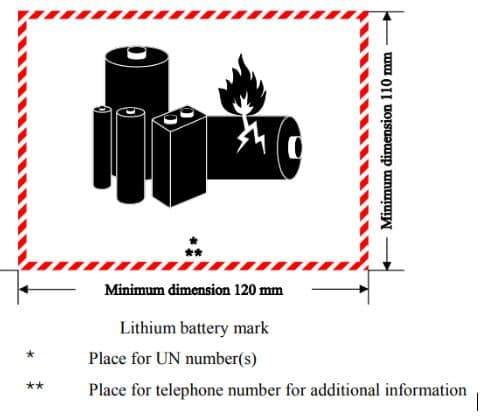
What to do with damaged lithium batteries?
Lithium batteries: The risk of thermal runaway
One significant danger associated with lithium batteries is the potential for thermal runaway—a self-oxidising chain reaction that occurs within the battery, generating intense heat and gas. This can lead to extremely high temperatures, reaching around 700-800°C, often resulting in fires and explosions. What makes thermal runaway particularly challenging is that it can occur before visible flames are present, making early detection and prevention difficult.
The following factors can trigger thermal runaway:
- Physical damage or compression of the battery causing internal short circuits.
- Puncturing or damaging the battery’s outer casing resulting in a direct short circuit and the release of hazardous gases.
- Charging the battery beyond its recommended capacity causing excessive heat build-up.
- Exposure to high temperatures accelerating the risk.
- An unintended electrical connection between the positive and negative terminals of the battery causing a rapid release of energy and heat.
- Exposure of lithium to water causing a chemical reaction.
Is your lithium battery damaged?
There are several warning signs you can look out for to identify if your lithium battery is damaged.
These signs include:
- Bulging: If your battery appears bloated, it is a clear indication of internal damage. This is usually caused by the buildup of gas or electrolyte inside the battery.
- Leaking electrolyte: A damaged battery may leak electrolyte, which is a fluid or gel-like substance.
- Unusual smells: Strong or unusual smells can indicate internal damage. Any acidic or chemical-like odours should be taken seriously.
- Overheating: These batteries should not become excessively hot during normal operation.
- Device malfunctions: If a device powered by the battery starts to behave erratically, it could be a sign the battery is damaged.
It’s important to note that in some cases, it may be difficult to visually determine if a battery is damaged or compromised. That’s why it’s critical to always prioritise safety and take appropriate precautions.
If in doubt, it is best to be on the side of caution and seek expert advice by calling Biffa on 0121 505 1616 (option 2) to ensure the proper handling and disposal of potentially damaged batteries.
How to store a damaged lithium battery
These batteries have the potential to leak electrolyte, so it is important to wear appropriate personal protective equipment (such as goggles, gloves, and an apron) when handling them. Contact between electrolyte and the skin can lead to skin irritation or burns.
Often the electrolyte is flammable. To store damaged batteries safely until proper disposal, you should place them in a fireproof container, such as a metal UN approved drum filled with chemically inert cushioning material like sand. The battery must be surrounded by the inert material (sand or specialised silica).
Avoid disposing of damaged batteries in general waste or recycling containers.
How to dispose of a damaged lithium battery
In the UK, there are additional legal obligations on batteries from the Batteries & Accumulators (placing on the market) regulations 2008. The primary aim of this legislation is to make it compulsory to collect and recycle batteries and accumulators, preventing batteries and accumulators being incinerated or sent to landfill and to restrict the substances used in batteries and accumulators.
At the moment, Lithium batteries are not classified as hazardous waste by the Hazardous Waste Regulations 2005. Lithium metal is, however, mentioned in the Environment Agency’s guidance on hazardous waste (WM3) as a substance whose presence could render a waste hazardous on account of its flammability.
When transporting damaged lithium batteries, it is important to package them properly to prevent any potential leaks, short circuits, or other hazards during transit (by using the steps stated above on how to store a damaged lithium battery). The packages containing damaged lithium batteries should also be clearly labelled with appropriate warnings and symbols.
These labels should indicate the presence of damaged batteries and highlight any potential hazards. If it meets the requirements of special provisions 188, then it shall be marked with the below label.

If it doesn’t then it will have a standard ADR label for lithium batteries such as the below.

How to mitigate risks and ensure safety?
Proper storage of lithium batteries is crucial for maintaining their integrity and minimising the risk of damage. Follow these guidelines for safe battery storage:
- Store batteries in a cool, dry place with stable temperatures. High temperatures can accelerate the risk of thermal runaway.
- Keep batteries away from direct sunlight, open flames, or sources of heat.
- Store batteries in non-conductive containers or original packaging to prevent short circuits and physical damage.
- Avoid storing batteries near flammable materials or volatile substances.
- Charging lithium batteries correctly is essential for their longevity and safety.
- Regular maintenance of lithium batteries can help identify potential issues and prevent damage. This includes inspecting the batteries for damage and cleaning the battery terminals.
- Have batteries removed by your waste contractor on a regular basis and in line with your legal waste authorisations / exemptions.
- Inspect waste battery storage area to identify any potential issues.
By implementing these preventive measures, you can significantly reduce the risk of battery damage, thermal runaway and associated hazards.
